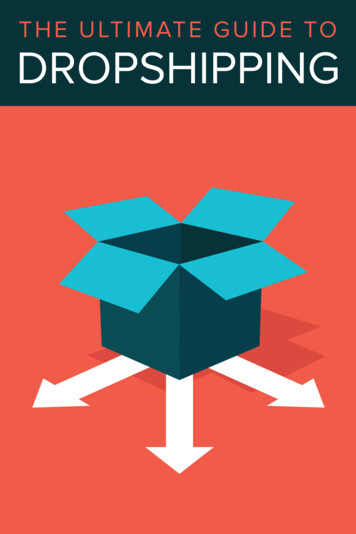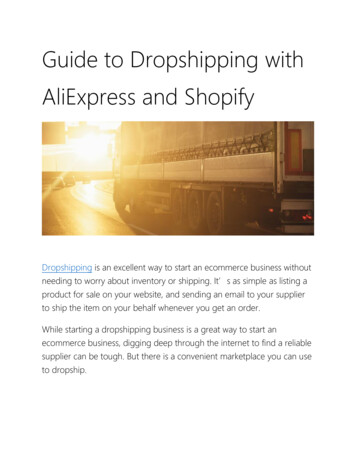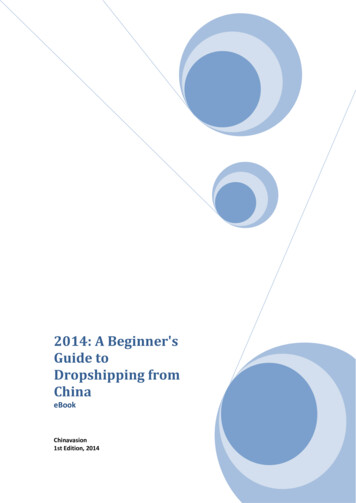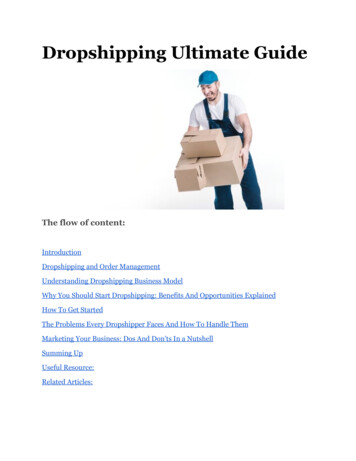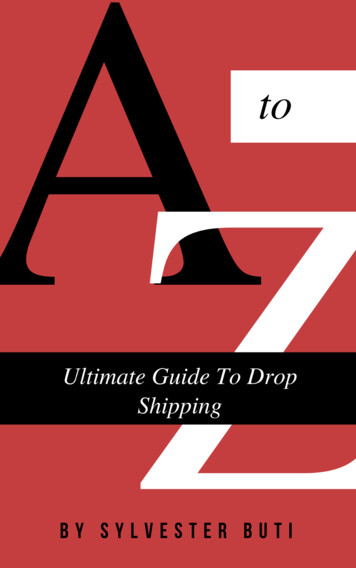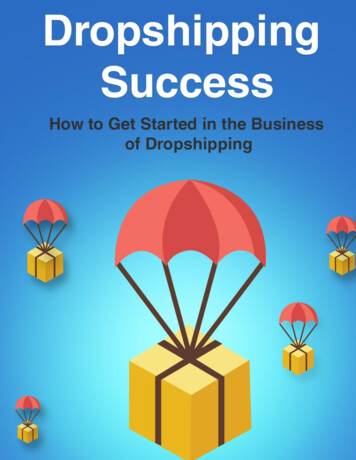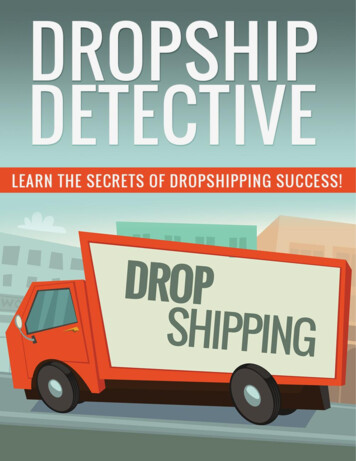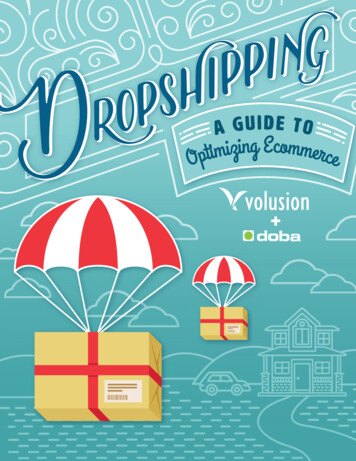
Transcription
A GUIDE TOEcgmzimmeitrcepO
Volusion is the leading provider of ecommerce solutions andservices for small and medium businesses. Used by over 40,000merchants, the Volusion platform offers a complete shoppingcart and fully-hosted website, along with effective marketingand merchandising tools for one affordable monthly rate. Tolearn more about Volusion and sign up for a free trial of itsaward-winning ecommerce platform, visit Volusion.com.Doba is a pioneer in the drop shipping industry since 2003,serving thousands of online retailers and wholesale suppliersacross all product categories. Doba simplifies productsourcing by consolidating millions of products from a networkof wholesale suppliers and manufacturers into a single B2Bcommerce platform. Products sold by the retailer are shippeddirectly to the retail customer from the supplier’s warehouse.Doba fills the gap between suppliers on one end and retailerson the other end by providing them with a common platformto conduct business and perform transactions . For moreinformation, visit the company website, Doba.com.
1. DROPSHIPPING: WHAT IS IT?52. IT ALL STARTS WITH ASSORTMENT63. SUPPLIER RELATIONSHIPS: DATE BEFORE YOU MARRY84. DROPSHIPPING ISN'T JUST FOR THE LITTLE GUYS95. LONG-TAIL PRODUCTS AND BRAND BUILDING106. DROPSHIPPING PITFALLS TO AVOID117. WHAT DROP SHIPPING WON'T DO FOR YOU128. A RETAILER'S PATH TO STARTING DROPSHIPPING13
DropshippingIS AVIABLE FULFILLMENT METHODFOR RETAILERS OF ALL SIZES. ITPROVIDES A GREAT STARTING POINTFOR SMALL OR JUST-STARTINGRETAILERS, AND SERVES A ROLE FORLARGER BUSINESSES AS WELL.THIS EBOOK AIMS TO DEFINE WHATDROPSHIPPING IS, WHAT IT CANDO FOR YOUR COMPANY ANDILLUSTRATE HOW TO SUCCESSFULLYUSE IT IN A VARIETY OF SITUATIONS.
Chapter 1DROPSHIPPING: WHAT IS IT?The phrase “dropshipping” is one that many retailersare familiar with, but many may not fully understandwhat it is.Dropshipping is a form of product fulfillment inwhich a customer’s order is shipped directly fromthe supplier, as opposed to shipping from a retailer.This model removes the need for a retailer to stockproducts in a warehouse, which saves the retailer alot of overhead expense.Dropshipping is used by a number of companies,large and small, all over the world. It’s a proven,effective model and is also a great strategy for smalland/or new retailers to start selling with less up-frontcapital.Oftentimes, dropshipping suppliers can get betterprices from couriers than a small or just-startingonline retailer. This means they can pass thosesavings along to you, the retailer.The dropshipping process looks somethinglike this: A customer visits your site and finds a productthey’d like to buy The customer places an order for the productfrom your store and pays you You pass that order information along to yourdropshipper, who keeps the products in stock intheir warehouse, and pay the wholesale price tothe supplier The dropshipper packages and ships theproduct directly to the customer You keep the margin between your retail priceand the supplier’s wholesale price as profitNow that we’ve explained what dropshipping is, we’regoing to look at many of the different factors that gointo successfully using dropshipping as a fulfillmentmethod.5
Chapter 2IT ALL STARTS WITH ASSORTMENTProper assortment is key in the retailing world. In fact,it’s even been called the most important job of seniorretail management.expand their product assortment with only the costof digitally onboarding the new products into theircatalog.In an article for the Harvard Business Review, authorsDieter and Nils Brandes said, “The biggest problemwith retailing today is that in too many companies,senior management neglects its most important job:to manage the assortment of goods and services theysell.”How do you go about increasing your assortment?Let’s go over a few steps.Without the proper assortment of products in yourstore, you’ll lose customers to retailers with a moreattractive mix of products.It will take time to find the right assortment ofproducts for your particular niche. You’ll need theitems that sell quickly and in large quantities, butyou’ll also want to make sure you have plenty of longtail items on hand to bundle with other products.For traditional retailers, increasing their assortmentmeans taking on more and more products in theirwarehouse without the guarantee the products willsell enough to become profitable. However, withdropshipping, that risk is eliminated and retailers canUnderstand what your customers are buyingThe first step in increasing your assortment is lookingat what your customers are already buying. Knowingwhat and when your customers are buying will helpyou add more relevant products to your catalog.For new retailers without access to extensive productand purchase data, using Amazon is a good way tofind products relevant to your core offering. At thebottom of a product page, Amazon upsells relatedproducts under the “Customers Who Bought ThisItem Also Bought” heading. Search for some of yourtop-selling products and see what other items arecommonly bought along with it.Let your customers’ buying habits guide yourassortment, instead of the other way around.For example,searching for aCanon EOS Rebel T5on Amazon showsthat customersare also frequentlybuying SD cards, aCanon EOS Rebel T5for Dummies bookand replacementbatteries.6
Experiment with your assortmentMerchandisingYour assortment should always be evolving, since thewants of consumers are constantly changing. Thisis where your own expertise comes in. You shouldbe selling in a niche you’re knowledgeable about(selling everything and anything is best left to big-boxretailers) and you must have insight into your industry.What would you like to see in the marketplace? Whatdo you think others in the industry would like to buy?Properly merchandising your products is anotheraspect of assortment management that’s importantto understand. However, merchandising can have a bitof a learning curve for new or small online retailers.The article from Harvard Business Review illustratesthis point by saying, “Be aware, too, that marketresearch can only tell you so much. But the beauty ofthe retail business is that managers are consumerstoo. Ask them to use their own instincts about thedifferent signals that would be sent by differentassortments.”Merchandising is the process of putting the rightproduct in front of the right customer at the righttime. It can be a time-consuming effort, but it’sworthwhile.Volusion has a few excellent blog posts onmerchandising, and we’ve linked to them here andhere.While you may not have managers, or even otheremployees for that matter, your opinions onassortment are valid precisely because you’re also aconsumer.7
Chapter 3SUPPLIER RELATIONSHIPS: DATE BEFORE YOU MARRYThis is a topic we touched on in the first chapter butneed to revisit in a bit more detail.For small and just-starting online retailers, a goodsupplier is very important. A good supplier can helpbuild your ecommerce brand, while a bad supplier isgoing to make doing business very difficult.Finding suppliers is easy; a search for “wholesaledropship suppliers” brings up roughly 731,000 resultsin Google. Finding good suppliers, however, is wherethe challenge lies.When you’re looking for a good supplier, look for allthe hallmarks of a good business. Do they have a realaddress? Phone number? Give them a call and askabout their operations. See if they have any othercurrent customers you can contact and see how theircustomer service is.One quick thing to take note of here: wholesalesuppliers are known throughout the industry tohave poorly-designed websites. So while looking fora supplier online, you may come across perfectlylegitimate companies whose sites look less thanlegitimate. Don’t take it at face value, and do yourresearch before jumping into anything.Some suppliers will charge a “drop fee” in additionto their shipping costs. This is a fee for packagingand shipping single items from a warehouse. Sincethe supplier in a dropshipping relationship bears thefinancial risk of warehousing the bulk inventory, theyoffset that risk in the form of the drop fee. Seeingthat a supplier charges a drop fee isn’t the sign of ascam or a seedy dropshipper; it’s a very common andaccepted practice.8
Chapter 4DROPSHIPPING ISN’T JUST FOR THE LITTLE GUYSWhile dropshipping is a great method for smallerretailers, it’s not exclusive to that area of the retailmarket. Those who run a larger ecommerce businesscan (and should) take advantage of the benefitsdropshipping has to offer.We’ve already gone over how dropshipping isbeneficial for larger retailers looking for newsuppliers, as well as the benefits it presents for thoseretailers looking to increase their assortment withoutany additional overhead.So let’s take a look at a few other ways largercompanies can utilize dropshipping.Market testingRolling out new products can present a businesswith some different challenges. For most retailers,introducing a new product to their catalog meansthat they’ll be stocking a large amount of the productwithout any guarantee it will sell.Seasonal productsDropshipping provides a great solution for retailerslooking to stock and sell more seasonal items.Keeping Christmas lights and Halloween decorationsin stock year-round may not be viable for someretailers, and it’s not always easy to find storage spacefor them when the season to sell comes around.Utilizing a dropship supplier to send your seasonalgoods is a great way to provide your customers withthese products without finding a spot for them inyour warehouse.Larger retailers can also benefit from the long-tail andbrand building benefits dropshipping provides. We gointo detail on both of those in the “Long-Tail Productsand Brand Building” section of this eBook.This is why so many retailers are focused on markettesting: gauging customer interest in a productbefore launching a full-scale rollout will reduce therisk involved in this process.Dropshipping can help retailers reduce this risk evenfurther. Before buying a bulk amount of the productto ship out from a warehouse, large retailers caninstead begin selling new products via dropshipping.If the product sells well, they can move towards abulk purchase agreement with a supplier and sell theitems from their own warehouse, knowing that they’llbe able to move the product quickly.The dropshipping model also gives retailers moreoptions for selling a product throughout its entirelife cycle, which leads us to the next point: seasonalitems.9
Chapter 5LONG-TAIL PRODUCTS AND BRAND BUILDINGDropshipping offers bigger retailers and ecommercebrands unique opportunities to experiment with longtail products, and build their brand at the same time.Long-tail solutionThe long-tail theory, developed by Chris Anderson, ispretty simple. According to longtail.com, the theoryof long-tail is that, “As the costs of production anddistribution fall, especially online, there is now less aneed to lump products and consumers into one-sizefits-all containers. In an era without the constraintsof physical shelf space and other bottlenecks ofdistribution, narrowly-targeted goods and servicescan be as economically attractive as mainstreamfare.”Not every product you stock needs to be a big-ticket,top-selling item. Stocking plenty of niche-relatedproducts that sell steadily over time is a necessity intoday’s retail world.For retailers with limited warehouse space, stockingenough long-tail products to meet demand may notbe viable. Dropshipping offers a way for retailers tocontinue selling the valuable long-tail products theyneed to while not taking up valuable warehousespace.Strategic brand partnershipsFor large, vertically-integrated brand retailers,dropshipping may not seem like a viable option. Afterall, one of the biggest benefits of doing business asa vertically-integrated brand is the fact that everyaspect of product production is owned by thecompany, lessening costs and ensuring a higherquality of products.However, we’ve seen some big vertically-integratedbrand retailers utilize dropshipping as a way to createbrand partnerships. The best example of this is Apple.Apple bought Beats a few years ago, but before thenhad been selling their headphones in Apple stores. Infact, in 2013, Apple sold over 1 billion worth of Beatsheadphones.This relationship illustrates how large brands canidentify other relevant products in their niche, andthusly move into a partnership to sell those products.This eliminates the additional cost of a brandproducing their own product. You’d be offering a thirdparty product bundled with one of your own, withoutthe production cost of the new item.For larger retailers, this kind of a relationship isbeneficial for both parties, and you don’t have tobuy the other company the way that Apple boughtBeats. Partnering with other respected brands willincrease your own brand’s image in the eyes of manyconsumers.10
Chapter 6DROPSHIPPING PITFALLS TO AVOIDDropshipping is a valuable and viable fulfillmentmethod, but that doesn’t mean it comes withoutpotential drawbacks. There are some pitfalls in thedropshipping world that you need to anticipate andavoid if you want to have success with it.you have a potentially significant customer serviceadvantage over larger retailers who don’t know theproduct.Don’t compete on price aloneEstablishing your own branded retail channel is acritical piece of your growth puzzle in the onlineretail world. Even so, some items will sell better onAmazon, eBay or even Facebook. A lot of successfuldropship merchants online are cross-channel sellers,with products on their own site as well as otherecommerce marketplaces.This is a topic we touched on earlier, but it’s worthrevisiting.Wal-Mart can afford to sell some of its products at aloss because they sell such a massive volume of otherprofitable items. As a smaller online retailer, you can’tafford to operate on that kind of scale.Trying to compete in the online world on price aloneisn’t a viable strategy. Instead, look for other waysto add value to your products through your industryexpertise, or packaging items together to reduce totalcost.Don’t sell what everyone else is sellingBecause dropshipping lowers the barrier to entryfor many smaller retailers, online marketplaces arefull of thousands of less-experienced sellers tryingto sell the same products. If you go into businesstrying to sell the same hot products as everyoneelse, you’ll quickly become frustrated. When a largenumber of businesses are selling the same product,that increased competition drives down prices. Thismeans that the only sellers making any kind of aprofit on these items are the big-box retailers, andcompeting with them isn’t worth your time as a smallor just-starting online retailer.Don’t sell what you don’t knowFor smaller retailers, selling a product you’reknowledgeable about is incredibly important. Sinceyou can’t always compete with bargain-basementprices, you have to focus on adding value elsewherein your customer’s buying process. When you’reknowledgeable about the products you’re selling,Don’t sell solely in one marketplaceYou don’t want to miss out on customers who arelooking for what you’re selling but don’t know thatyour site exists. Selling on Amazon and eBay is a greatway to increase your business’ reach.There are a lot of great tools that exist to help you sellmore effectively on Amazon and eBay. Volusion offersseamless integration with eBay and Amazon.Don’t overlook your shipping cost strategyA study conducted by Amazon found that 46% ofcustomers will abandon their shopping cart if freeshipping isn’t offered. That’s a pretty high number.You may not always be in a position to offer freeshipping on all items (i.e., long tail items with asmaller profit margin) but you should at leastexperiment with shipping rates to try and provide thecheapest options to your customers.Remember that dropship fee we mentioned thatsome dropship suppliers charge? You don’t have topass that along to your customers in the form of ahigher shipping charge; instead, work that fee into thetotal cost of the product being sold.If you’d like more information on dropshipping dosand don’ts, you can read a free whitepaper about ithere.11
Chapter 7WHAT DROPSHIPPING WON’T DO FOR YOUWhile there are a lot of benefits to using dropshippingas a fulfillment method, it’s important to understandwhat it won’t do for you.It won’t make you rich overnightMany dropshipping companies are run on nightsand weekends, as secondary sources of income fortheir owners. This means retail businesses that usedropshippers aren’t going to get rich overnight.That’s not to say you can’t be successful with sellingonline. Understand that doing so will require time anda big commitment on your part to grow your business,build your brand and begin winning loyal customers.It won’t absolve you of customer service dutiesJust because your products are delivered by a thirdparty supplier doesn’t mean you aren’t responsible forcustomer service. Your customers won’t know thatyou utilize dropshipping, and in all reality, they won’tcare. It’s up to you to solve any supplier issues thatarise, and to ensure that your customers are satisfied.Dropshipping can do a lot for online retailers, but it’simportant to properly understand its limitations soyou know what to expect going in.12
Chapter 8HOW TO GET STARTED WITH DROPSHIPPINGIf you’re a new or small online retailer looking toutilize dropshipping as a fulfillment method, gettingstarted isn’t a complicated process. However, it willtake some time and work on your part in order to getthings working smoothly.Contact suppliersIdentify a nicheThe most effective way is going to be to search onlinefor wholesale dropshipping suppliers.Knowing which products you’re going to sell willdetermine which dropship suppliers you contact.Therefore, picking a niche in which to sell will helpyou narrow the choices when looking for a supplier.We’ve already discussed the reasons why you, as asmall retailer, need to focus your offering in order toget established and profitable. Selling in a niche willestablish your ecommerce site as a brand, which youcan then build and leverage to expand your business.Build a siteSite building is important, as we’ve already discussed.Luckily, building a website doesn’t require you to bea coding genius. Plenty of software solutions, likeVolusion, exist. They’ll help you create a good-looking,responsive site without any knowledge of HTML orother programming languages.Consider a business licenseWhen you reach out to contact a potential supplier,having your business license lends more credibilityto your query. Additionally, most cities require thata business license be purchased before any officialtransactions begin. Make sure to check your locallaws regarding this step.Once your other housekeeping items have beentaken care of, you can begin contacting suppliers.There are a number of ways to do this.Thoroughly research the companies you comeacross. Call them, ask questions and pester theircurrent customers: anything you can do to ensurethat the supplier you’re considering is worth your timeand money. While there’s no such thing as a perfectsupplier, you should be looking for suppliers who dohonest business and demonstrate consistency ingetting the products to your customers quickly.There are companies out there that offer suppliercatalogs, or even software, that lists verified suppliersin one location. If you’re having trouble finding goodsuppliers in your niche, it might be worth your time tolook at a supplier catalog.Successfully utilizing dropshipping as a fulfillmentmethod is viable for any size of business, but it canespecially help small or new online retailers whoare looking to get into the game. For most retailers,the affordability and ease of access provided by thedropshipping model can’t be beat.13
interested inVolusioncan help
1. dropshipping: what is it? 5 2. it all starts with assortment 6 3. supplier relationships: date before you marry 8 4. dropshipping isn't just for the little guys 9 5. long-tail products and brand building 10 6. dropshipping pitfalls to avoid 11 7. what drop shipping won't do for you 12 8. a ret
